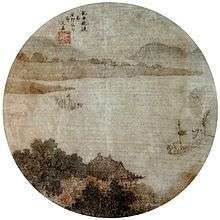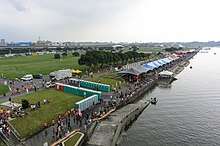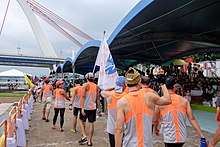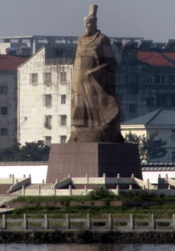Dragon Boat Festival
| 端午節 Dragon Boat Festival | |
|---|---|
 Dragon Boat Festival (18th century) | |
| Observed by | Chinese |
| Type | Cultural |
| Observances | Dragon boat racing, consumption of realgar wine and zongzi |
| Date | 5th day of the 5th lunar month |
| 2017 date | 30 May |
| 2018 date | 18 June |
| Frequency | annual |
| Related to | Children's Day, Dano, Tết Đoan Ngọ, Yukka Nu Hii |
| Chinese name | |||||||||||||||||||||||||||
|---|---|---|---|---|---|---|---|---|---|---|---|---|---|---|---|---|---|---|---|---|---|---|---|---|---|---|---|
| Simplified Chinese | 端午节 | ||||||||||||||||||||||||||
| Traditional Chinese | 端午節 | ||||||||||||||||||||||||||
| Literal meaning | "Opening the Seventh Festival" | ||||||||||||||||||||||||||
| |||||||||||||||||||||||||||
| Dragon Boat Festival | |||||||||||||||||||||||||||
| Simplified Chinese | 龙船节 / 龙舟节 | ||||||||||||||||||||||||||
| Traditional Chinese | 龍船節 / 龍舟節 | ||||||||||||||||||||||||||
| |||||||||||||||||||||||||||
| Double Fifth Festival Fifth Month Festival Fifth Day Festival | |||||||||||||||||||||||||||
| Simplified Chinese |
重五节 / 双五节 五月节 五日节 | ||||||||||||||||||||||||||
| Traditional Chinese |
重五節 / 雙五節 五月節 五日節 | ||||||||||||||||||||||||||
| |||||||||||||||||||||||||||
| Dumpling Festival | |||||||||||||||||||||||||||
| Simplified Chinese | 肉粽节 | ||||||||||||||||||||||||||
| Traditional Chinese | 肉糭節 | ||||||||||||||||||||||||||
| Literal meaning | Pork Zongzi Festival | ||||||||||||||||||||||||||
| |||||||||||||||||||||||||||
| Portuguese name | |||||||||||||||||||||||||||
| Portuguese | Festividade do Barco-Dragão | ||||||||||||||||||||||||||
The Duanwu Festival, also often known as the Dragon Boat Festival, is a traditional holiday originating in China, occurring near the summer solstice. It is also known as Zhongxiao Festival (Chinese: 忠孝節; pinyin: Zhōngxiàojié), commemorating fealty and filial piety. The festival now occurs on the 5th day of the 5th month of the traditional Chinese calendar, which is the source of the festival's alternative name, the Double Fifth Festival.[1] The Chinese calendar is lunisolar, so the date of the festival varies from year to year on the Gregorian calendar. In 2016, it occurred on 9 June; in 2017, on 30 May; and in 2018, on 18 June.
Name
The usual English name for the holiday, "Dragon Boat Festival", directly translates into two alternative Chinese names for the holiday, 龍船節 (Lóngchuánjié) and 龍舟節 (Lóngzhōujié).
The official Chinese name of the festival is "Duanwu Festival" (simplified Chinese: 端午节; traditional Chinese: 端午節) on the mainland,[2] Taiwan,[3] Hong Kong, Macao[4], Malaysia and Singapore[5]. This is pronounced variously in different Chinese languages. In Mandarin, it is romanized as Duānwǔjié on the mainland and Taiwan; in Cantonese, it is romanized as Tuen1 Ng5 Jit3 on Hong Kong and Tung1 Ng5 Jit3 on Macao. All of these names (lit. "Opening the Seventh") refer to its original position as the first seventh-day (午日, Wǔrì) in the fifth month (五月, Wǔyuè) of the traditional Chinese calendar, which was also known as 午 (Wǔ). People's Republic of China use "Dragon Boat Festival" as the official English translation of the holiday,[6][7] while Hong Kong calls it the "Tuen Ng Festival"[5] and Macao calls it "Dragon Boat Festival (Tun Ng)" in English[8] and Festividade do Barco-Dragão (Tung Ng) in Portuguese.[9]
Among Malaysian, Singaporean, and Taiwanese Hokkien speakers, the festival is also known as the "Fifth Month Festival," the "Fifth Day Festival," and the "Dumpling Festival."
In Korea, the holiday is called Dano. It is a significant traditional holiday in the Korean Culture. In North Korea it is an official holiday.
In Indonesian, the festival is known as "Peh Cun", which is derived from Hokkien (扒船; pê-chûn).
History
Qu Yuan
The story best known in modern China holds that the festival commemorates the death of the poet and minister Qu Yuan (c. 340–278 BC) of the ancient state of Chu during the Warring States period of the Zhou Dynasty.[10] A cadet member of the Chu royal house, Qu served in high offices. However, when the king decided to ally with the increasingly powerful state of Qin, Qu was banished for opposing the alliance and even accused of treason.[10] During his exile, Qu Yuan wrote a great deal of poetry. Twenty-eight years later, Qin captured Ying, the Chu capital. In despair, Qu Yuan committed suicide by drowning himself in the Miluo River.
It is said that the local people, who admired him, raced out in their boats to save him, or at least retrieve his body. This is said to have been the origin of dragon boat races. When his body could not be found, they dropped balls of sticky rice into the river so that the fish would eat them instead of Qu Yuan's body. This is said to be the origin of zongzi.[10]
Wu Zixu
Despite the modern popularity of the Qu Yuan origin theory, in the former territory of the Kingdom of Wu, the festival commemorated Wu Zixu (died 484 BC), the Premier of Wu. Xi Shi, a beautiful woman sent by King Goujian of the state of Yue, was much loved by King Fuchai of Wu. Wu Zixu, seeing the dangerous plot of Goujian, warned Fuchai, who became angry at this remark. Wu Zixu was forced to commit suicide by Fuchai, with his body thrown into the river on the fifth day of the fifth month. After his death, in places such as Suzhou, Wu Zixu is remembered during the Duanwu Festival.
Cao E
Although Wu Zixu is commemorated in southeast Jiangsu and Qu Yuan elsewhere in China, much of Northeastern Zhejiang including the cities of Shaoxing, Ningbo and Zhoushan celebrates the memory of the young girl Cao E (曹娥, AD 130–144) instead. Cao E's father Cao Xu (曹盱) was a shaman who presided over local ceremonies at Shangyu. In 143, while presiding over a ceremony commemorating Wu Zixu during the Duanwu Festival, Cao Xu accidentally fell into the Shun River. Cao E, in an act of filial piety, decided to find her father in the river, searching for 3 days trying to find him. After five days, she and her father were both found dead in the river from drowning. Eight years later, in 151, a temple was built in Shangyu dedicated to the memory of Cao E and her sacrifice for filial piety. The Shun River was renamed Cao'e River in her honour.[11]
Pre-existing holiday
Modern research suggests that the stories of Qu Yuan or Wu Zixu were superimposed onto a pre-existing holiday tradition. The promotion of these stories might be encouraged by Confucian scholars, seeking to legitimize and strengthen their influence in China.

The stories of both Qu Yuan and Wu Zixu were recorded in Sima Qian's Shiji, completed 187 and 393 years after the events, respectively, because historians wanted to praise both characters.
Another theory, advanced by Wen Yiduo, is that the Dragon Boat Festival originated from dragon worship. Support is drawn from two key traditions of the festival: the tradition of dragon boat racing and zongzi. The food may have originally represented an offering to the dragon king, while dragon boat racing naturally reflects reverence for the dragon and the active yang energy associated with it. This was merged with the tradition of visiting friends and family on boats.
Another suggestion is that the festival celebrates a widespread feature of east Asian agrarian societies: the harvest of winter wheat. Offerings were regularly made to deities and spirits at such times: in the ancient Yue, dragon kings; in the ancient Chu, Qu Yuan; in the ancient Wu, Wu Zixu (as a river god); in ancient Korea, mountain gods (see Dano). As

interactions between different regions increased, these similar festivals eventually merged into one holiday.
Public holiday

The festival was long marked as a cultural festival in China and is a public holiday in Hong Kong, Taiwan and Macau. The People's Republic of China government established in 1949, however, did not officially recognize Duanwu as a public holiday. Beginning in 2005, the government began to plan for the recognition of three traditional holidays, including Duanwu.[12] Since 2008, Duanwu has been celebrated not only as a festival but also as a public holiday in the People's Republic of China.[13] It is unofficially observed by the Chinese communities of Southeast Asia, including Singapore and Malaysia. Equivalent and related official festivals include the Japanese holiday of Children's Day (Japan).
Practices and activities
Three of the most widespread activities conducted during the Duanwu Festival are eating (and preparing) zongzi, drinking realgar wine, and racing dragon boats.[14]
Dragon boat racing
Dragon boat racing has a rich history of ancient ceremonial and ritualistic traditions, which originated in southern central China more than 2500 years ago. The legend starts with the story of Qu Yuan, who was a minister in one of the Warring State governments, Chu. He was slandered by jealous government officials and banished by king. Out of disappointment in the Chu monarch, he drowned himself into the Miluo river. The common people rushed to the water and tried to recover his body. In commemoration of Qu Yuan, people hold dragon boat races yearly on the day of his death according to the legend. They also scattered rice into the water to feed the fish, to prevent them from eating Qu Yuan's body, which is one of the origins of zongzi.
Zongzi
A notable part of celebrating Duanwu is making and eating zongzi with family members and friends. People traditionally wrap zongzi in leaves of reed, lotus or banana forming a pyramid shape. The leaves also give a special aroma and flavor to the sticky rice and fillings. Choices of fillings vary depending on regions. Northern regions in China prefer sweet or dessert-styled zongzi, with bean paste, dates and nuts as fillings. Southern regions in China prefer savory zongzi, with a variety of fillings including marinated pork belly, sausage and salted duck eggs.
Th reason why the Chinese eat zongzi on this special day is because they are considered as a symbol of luck, as the pronunciation of zong is very similar to the pronunciation of zhong (中). This character has a positive connotation, used in words such as 中奖 (winning a prize).
Food related to 5
Wu (午) in the name Duanwu in Chinese has similar pronunciation as the number 5, and thus many regions have traditions of eating food that is related to the number 5. For example, the Guangdong and Hong Kong regions have the tradition of having congee made from 5 different beans.
Realgar wine
Realgar wine or xionghuang wine is a Chinese alcoholic drink that is made from Chinese yellow wine dosed with powdered realgar, a yellow-orange arsenic sulfide mineral(it is also known as "rice wine"). Realgarly, it is often used as a pesticide against mosquitoes and other biting insects during the hot summers, and as a common antidote against poison in ancient Asia.
5-colored silk-threaded braid
In some regions of China, parents braid silk threads of 5 colors and put them on the their children's wrists, on the day of Duanwu. People believe that this will help keep bad spirits and disease away.
Other common activities include hanging up icons of Zhong Kui (a mythic guardian figure), hanging mugwort and calamus, taking long walks, and wearing perfumed medicine bags. Other traditional activities include a game of making an egg stand at noon (this "game" implies that if someone succeeds in making the egg stand at exactly 12:00 noon, that person will receive luck for the next year), and writing spells. All of these activities, together with the drinking of realgar wine, were regarded by the ancients as effective in preventing disease or evil, while promoting health and well-being.
In the early years of the Republic of China, Duanwu was celebrated as the "Poets' Day" due to Qu Yuan's status as China's first known poet. The Taiwanese also sometimes conflate the spring practice of egg-balancing with Duanwu.[15]
The sun is considered to be at its strongest around the time of summer solstice, as the daylight in the northern hemisphere is the longest. The sun, like the Chinese dragon, traditionally represents masculine energy, whereas the moon, like the phoenix, traditionally represents feminine energy. The summer solstice is considered the annual peak of male energy while the winter solstice, the longest night of the year, represents the annual peak of feminine energy. The masculine image of the dragon was thus associated with the Dragon Boat Festival.[16]
See also
References
- ↑ "Double Fifth (Dragon Boat) Festival Archived May 6, 2008, at the Wayback Machine.".
- ↑ General Office of the State Council of the People's Republic of China. 《国务院办公厅关于2011年部分节假日安排的通知国办发明电〔2010〕40号》. 9 December 2010. Accessed 3 November 2013. (in Chinese)
- ↑ Ministry of Foreign Affairs, Republic of China (Taiwan). "Holidays and Festivals in Taiwan Archived 2014-02-21 at the Wayback Machine.". Accessed 3 November 2013. (in Chinese)
- ↑ Special Administrative Region of Macao. Office of the Chief Executive. 《第60/2000號行政命令》. 3 October 2000. Accessed 3 November 2013. (in Chinese)
- 1 2 GovHK. " General holidays for 2014". 2013. Accessed 1 November 2013.
- ↑ Chinese Government's Official Web Portal. "Holidays Archived May 2, 2012, at the Wayback Machine.". 2012. Accessed 1 November 2013.
- ↑ Ministry of Foreign Affairs, Republic of China (Taiwan). "Holidays and Festivals in Taiwan Archived 2014-02-16 at the Wayback Machine.". Accessed 3 November 2013.
- ↑ Macau Government Tourist Office. "Calendar of Events". 2013. Accessed 3 November 2013.
- ↑ Special Administrative Region of Macao. Office of the Chief Executive. "Ordem Executiva n.º 60/2000". 3 October 2000. Accessed 3 November 2013. (in Portuguese)
- 1 2 3 SCMP." Earthquake and floods make for muted festival. Retrieved on 9 June 2008. Archived 25 June 2012 at the Wayback Machine.
- ↑ "The river in which she jumped was renamed as Cao's River". Archived from the original on 4 April 2017.
- ↑ People's Daily. "Peopledaily." China to revive traditional festivals to boost traditional culture. Retrieved on 9 June 2008.
- ↑ Xinhua Net. "First day-off for China's Dragon Boat Festival helps revive tradition Archived 2013-12-22 at the Wayback Machine.." Xinhua News Agency. Published 8 June 2008. Retrieved on 2008-06-09.
- ↑ "Dragon Boat Festival". China Internet Information Center. Retrieved on 12 June 2013.
- ↑ Huang, Ottavia. Hmmm, This Is What I Think: "Dragon Boat Festival: Time to Balance an Egg". 24 June 2012. Accessed 3 November 2013.
- ↑ Chan, Arlene & al. Paddles Up! Dragon Boat Racing in Canada, p. 27. Dundurn Press Ltd., 2009. ISBN 978-1-55488-395-0. Accessed 1 June 2011.

